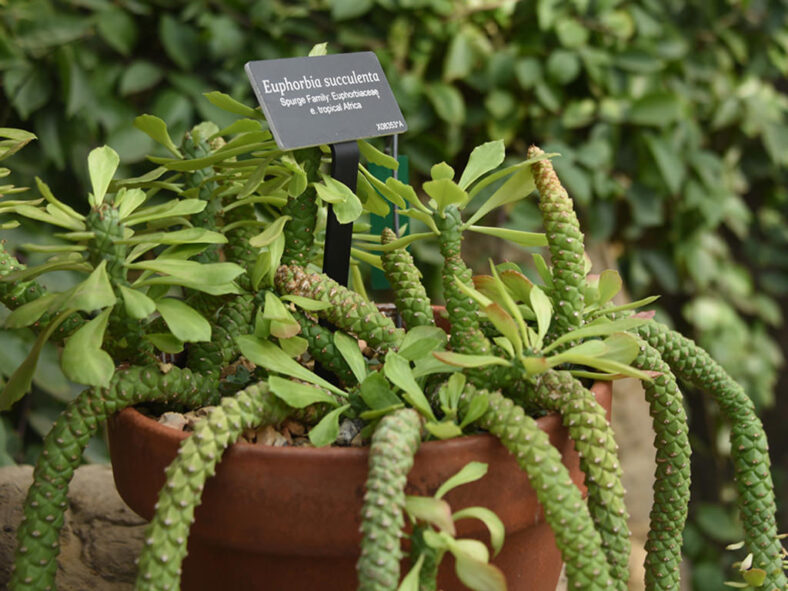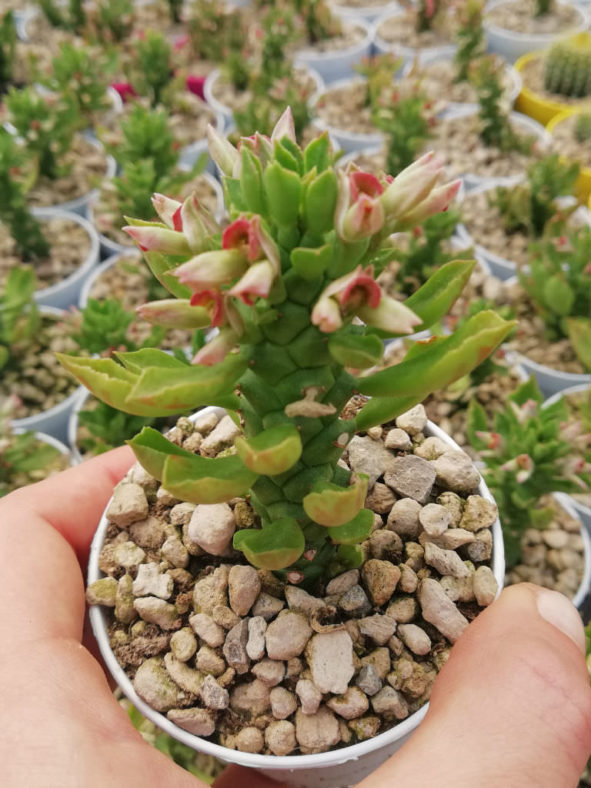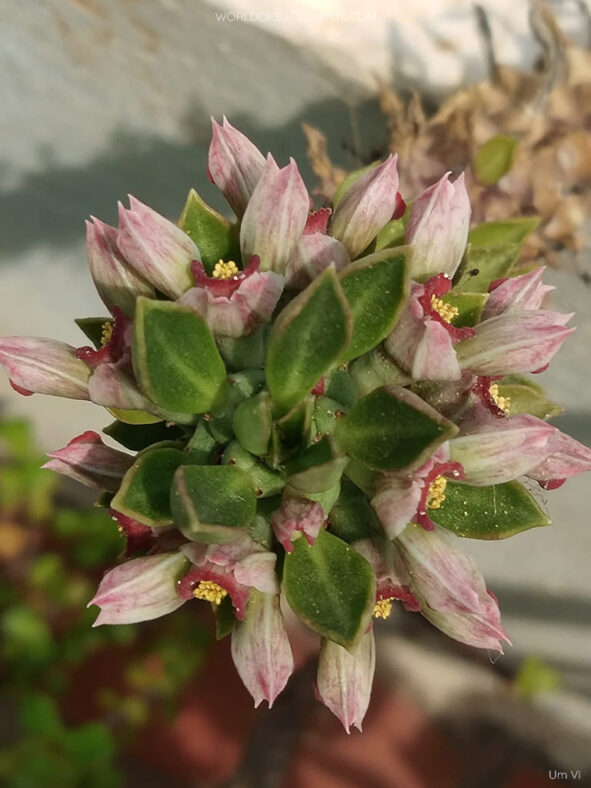Euphorbia succulenta is often confused with Euphorbia stapelioides. Here is a brief history of this confusion:
In 1909, Ferdinand Albin Pax described this species as Monadenium stapelioides. Later, in 1935, Herold G. W. J. Schweickerdt described Monadenium succulentum, believing it to be a different species. Over time, these two names were treated as synonyms, with Monadenium stapelioides being the older name and Monadenium succulentum becoming forgotten.
In 2006, Peter Vincent Bruyns wanted to move Monadenium stapelioides into the genus Euphorbia. However, he could not use the name Euphorbia stapelioides because it was already used for an existing species. As a result, he introduced the new name Euphorbia neostapelioides. In 2007, after discovering an older, forgotten synonym that should have been used, he formally established the name Euphorbia succulenta.
Scientific Name
Euphorbia succulenta (Schweick.) Bruyns
Synonym(s)
Euphorbia neostapelioides, Euphorbia succulenta var. succulenta, Monadenium stapelioides, Monadenium succulentum
Scientific Classification
Family: Euphorbiaceae
Subfamily: Euphorbioideae
Tribe: Euphorbieae
Subtribe: Euphorbiinae
Genus: Euphorbia
Etymology
The specific epithet "succulenta" (pronounced "suk-yoo-LEN-tuh") means "sappy, succulent" and probably refers to the white, milky sap that, like all Euphorbias, this species produces when stems or leaves are damaged.
Origin
Euphorbia succulenta is native to Kenya, Tanzania, and Uganda. It grows on rocky ground with slightly better drainage within grassland habitats.
Description
Euphorbia succulenta, formerly known as Monadenium stapelioides, is a succulent subshrub with a stout, fleshy main stem and numerous dark green branches with rhomboid, spirally arranged tubercles. The cylindrical, fleshy branches primarily grow from the base or sometimes from the top of the main stem. Initially erect, they become decumbent as they mature, reaching lengths of up to 12 inches (30 cm) and a diameter of 0.8 inches (2 cm). The fleshy, lance-shaped leaves are dark green, often marbled with purple, and can measure up to 0.5 inches (1.2 cm) in length and 0.25 inches (0.6 cm) in width. They are deciduous and typically found at the tips of the branches, appearing at the end of the tubercles.
During the spring and summer, Euphorbia succulenta produces clusters of three greenish-white flower heads (cyathia) flushed with pink. The cyathia appear at the end of the branches and arise in the axils of the tubercles on short stalks. Although small, they become striking when produced in large numbers. The fruits are sharply 3-angled capsules with two toothed wings along each angle and contain pale grey seeds.
Euphorbia succulenta is a variable species, showing variations in branch diameter, the number and size of the tubercles, leaf shape, and the length of the inflorescences.

How to Grow and Care for Euphorbia succulenta
Light: For optimal growth, your Euphorbia succulenta needs plenty of sunlight. Place it near a sunny window or move it to your balcony or garden during the warmer months, gradually increasing sun exposure to avoid sunburn.
Soil: Use a commercial potting mix designed for succulents or create your own well-draining mix.
Temperature: While high summer temperatures are not a problem, low winter temperatures can damage or kill your plant. Euphorbia succulenta grows best in USDA Plant Hardiness Zones 10a to 11b, with average minimum winter temperatures ranging from 30°F to 50°F (-1.1°C to 10°C).
Watering: From spring to fall, water the plant when the top inch (2.5 cm) of soil feels dry. Reduce watering in winter and give the plant just enough water to prevent it from wilting. In the warm season, evening is the best time of the day for watering.
Fertilizing: To ensure the potted plant receives sufficient nutrients, apply a balanced fertilizer in a 10-10-10 NPK formulation, diluted to 1/4 strength weekly during the growing season.
Repotting: Although your Euphorbia succulenta does not need to be repotted often, it will benefit from repotting when it outgrows its pot. Repotting is best done in early spring, at the beginning of the growing season. Wear gloves, protective clothing, and appropriate eye protection when handling this plant.
Propagation: The easiest and fastest method to propagate this plant is by stem cuttings. While starting Euphorbia succulenta from seeds is possible, germination can be challenging. Take cuttings only during the growing season. Spring is the ideal time to sow the seeds.
Learn more at How to Grow and Care for Euphorbia.
Toxicity of Euphorbia succulenta
Euphorbia succulenta produces a poisonous white milky sap that may cause burns or irritation if it comes into contact with the skin or eyes. Therefore, it's best to keep this plant out of reach of children and pets.
Forms of Euphorbia succulenta
Links
- Back to genus Euphorbia
- Succupedia: Browse succulents by Scientific Name, Common Name, Genus, Family, USDA Hardiness Zone, Origin, or cacti by Genus
Photo Gallery


